Managing a kindergarten classroom can feel like herding cats on a good day. You’re juggling diverse needs, ceaseless energy, and the developmental variations that make each child unique.
Effective classroom management is crucial not just for maintaining your sanity, but also for creating an environment where learning thrives.
This blog delves into proven tips, expert-backed preschool classroom management strategies, and even evidence-based practices that can transform your classroom.
The Importance of Classroom Management in Early Education

Influencing Early Childhood Development Outcomes Through Structure
Structure isn’t a “nice-to-have”; it’s essential. It creates a framework within which kids can explore safely. Think of daily routines like morning meetings or circle time as guardrails on a highway—they keep things moving smoothly.
Boosting Learning Outcomes and Fostering Learning
Chaos distracts, while order fosters learning. A well-managed classroom reduces anxiety, boosts engagement, and increases the time spent on academic tasks. In other words, classroom management is a cornerstone for effective learning.
Setting the Stage for Future Academic Success
Good habits start young. Effective classroom management helps students develop skills like self-regulation, focus, and social interaction. These are building blocks for future academic success.
11 Proven Classroom Management Tips for Preschool Teachers
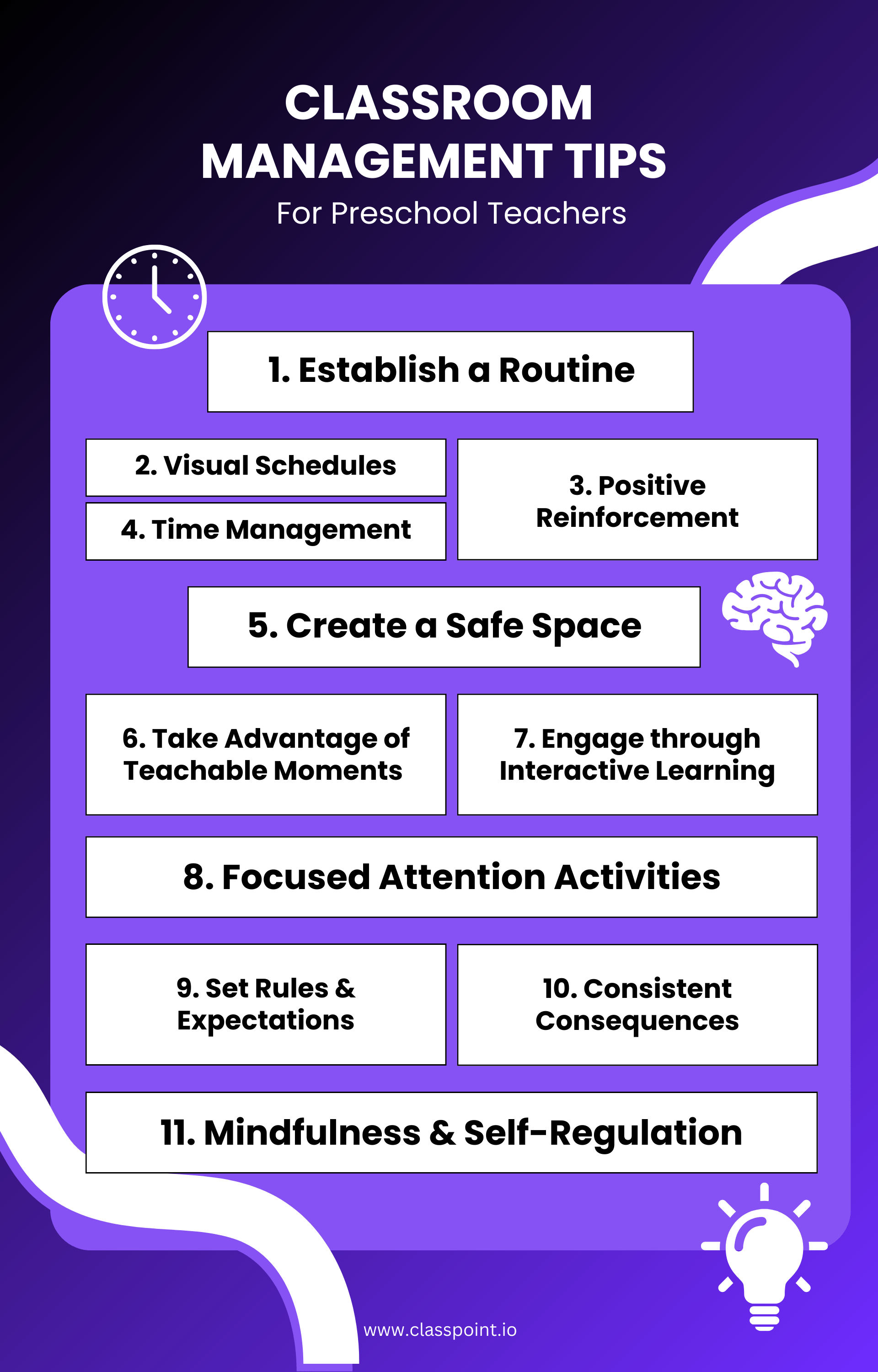
Let’s dive into some classroom management strategies for preschool that are not only tried-and-true but also easily adaptable for kindergarten. Trust me, these methods are gold—rooted in years of research and practical classroom experience.
1. Establishing Routines
Structure is your best friend in a preschool classroom. Setting up daily routines like circle time, morning greetings, and cleanup rituals provides a sense of predictability.
A Harvard study notes that predictable routines help children feel safe.
Tip: Create a visual chart to indicate the sequence of activities, but allow some flexibility for impromptu learning experiences.
2. Visual Schedules
If a picture is worth a thousand words, imagine how much a visual schedule can communicate to your preschoolers! Use icons to represent different tasks or activities.
The benefit? Children can follow along and start to manage their time even before they can read.
3. Positive Reinforcement
The art of reinforcement is all about timing and choice of reward. According to psychology research, immediate and tangible rewards like stickers or small treats have a stronger impact on younger kids. Maintain a reward chart to track progress and boost morale.
4. Time Management Techniques
Why should adults have all the Pomodoro fun? For kids, you can adapt this by using playful classroom timers or setting songs to signify transitions. The trick lies in making it fun. A controlled sense of time helps kids focus and better manage their activities.
5. Creating a Safe Space
Ensuring safety is non-negotiable. Choose furniture with rounded edges, organize supplies within kids’ reach, and create an environment conducive to open communication. Research shows that physical and emotional safety contributes significantly to learning.
6. Utilize Teachable Moments
Spotted a child sharing a toy? Seize the moment! Turning spontaneous acts into lessons not only reinforces good behavior but also makes learning memorable.
For disruptions, a quick, gentle redirection can transform the situation into a positive learning experience.
7. Engage Through Interactive Learning
Interactive learning activities like group projects and touchscreen activities cut down on disruptive behavior because they’re engaging by nature.
Opt for activities that involve tactile experiences or teamwork, as they inherently keep kids focused and cooperative.
Tip: If you teach using PowerPoint, try turning your PowerPoint sides into interactive quiz experiences to engage with your kids.
8. Focused Attention Activities
Save time and restore order by mastering the art of getting attention. Techniques like clapping patterns or simple call-and-response phrases are classroom magic.
They redirect wandering minds and create an environment of focus and participation.
9. Rules and Expectations
Be explicit with your classroom rules, but don’t let it be a monologue. Involve the kids in the rule-making process to make them feel invested.
Research shows that this classroom procedure leads to better compliance and a harmonious classroom.
10. Consistent Consequences
If a child breaks a rule, ensure the consequence is immediate and consistent. Consistency is key here. For instance, losing a privilege should be implemented fairly across all students. This establishes a sense of justice and respect for rules.
11. Mindfulness and Self-Regulation
Incorporate simple mindfulness activities like deep breathing or using sensory jars to help kids manage their emotions. A study found that such practices can significantly improve focus and behavioral regulation in children.
2 Simple Yet Effective Kindergarten Classroom Management Ideas that Save the Day
Sometimes simplicity is the key to tackling complex challenges. When it comes to classroom management strategies for kindergarten, you don’t always need a grand plan. Here are two game-changing, simple ideas that can make a significant impact on your classroom’s dynamics.
12. The “Quiet Coyote” Hand Signal

Picture this: the classroom is buzzing, and you need everyone’s attention, like, yesterday. Enter the “Quiet Coyote” hand signal. This silent but commanding gesture involves you forming a “quiet coyote” with your hand: your pinky and thumb extended, while the other three fingers rest down. The kids will quickly associate this sign with “time to listen.”
- Easy to Implement: No special props or elaborate instructions. Just a simple hand gesture.
- Culturally Neutral: The signal transcends language barriers, making it inclusive.
- Immediate Impact: It’s a quiet yet powerful way to regain focus without raising your voice.
Studies like the ones from Early Childhood Education Journal have shown that non-verbal cues can be highly effective in classroom management.
13. The Color-coded Behavior Chart

Imagine a chart with different color levels indicating behavior statuses like ‘Excellent,’ ‘Good,’ ‘Needs Improvement,’ and so on. Children have a clothespin with their name, and based on their behavior, the pin moves up or down the chart.
- Visual Reminder: Kids can literally see where their behavior stands.
- Easy Monitoring: Teachers can glance at the chart for a quick behavior assessment.
- Promotes Self-Regulation: Children become more mindful of their actions when they see real-time changes.
This method aligns well with classroom management strategies for preschool and kindergarten, which often leverage visual cues. A report by the National Association for the Education of Young Children supports the use of visual strategies to guide behavior.
10 Expert-Backed Strategies for Classroom Management in Kindergarten
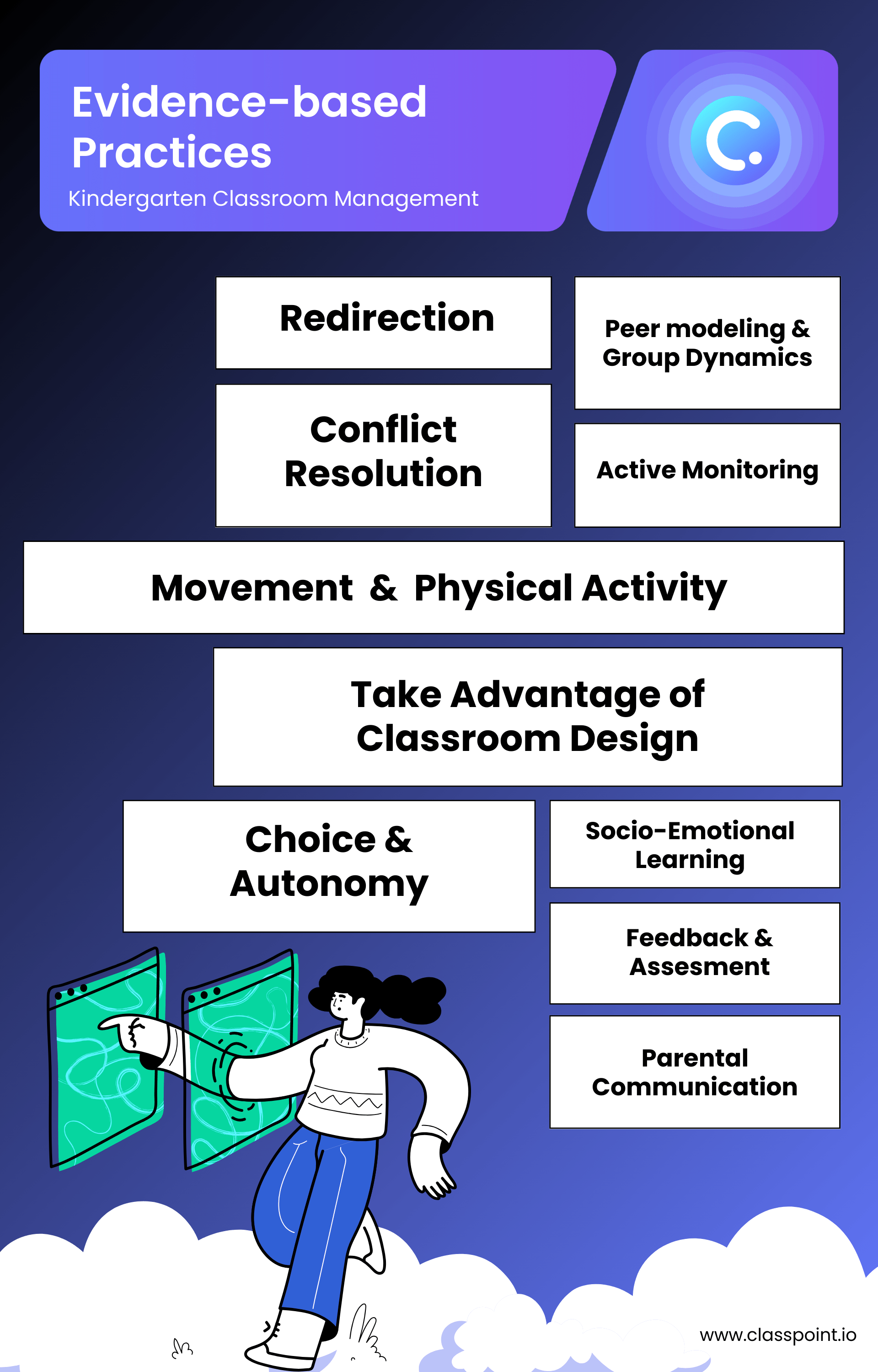
Looking to create a harmonious and productive kindergarten classroom? You’re in the right place! Here are 10 expert-backed classroom management strategies that can set you up for a successful year ahead.
14. Redirection Techniques
Experts like Dr. Jane Nelsen of Positive Discipline support using redirection to manage behavior. Redirection is the practice of shifting a child’s focus from undesirable behavior to constructive activity. Redirecting a child’s attention from a disruptive task to a positive one has proven effective. You can delve deeper into this approach in her book.
15. Group Dynamics and Peer Modeling
Peer modeling is a powerful tool. According to Dr. Karen Pryor’s research, children often imitate their peers’ good behavior, creating a ripple effect of positivity. Demonstrating a task with a well-behaved student can be especially effective.
For example, if a teacher wants to encourage students to clean up after themselves, she might select a student who already excels at this to demonstrate. The student could neatly put away their materials and wash their hands, providing a model for the other children to follow.
16. Conflict Resolution Skills
When conflicts arise, Dr. Laura Markham’s conflict resolution techniques can be invaluable. Her book includes approaches like active listening and validating feelings, strategies you can use to teach empathy and resolve disputes.
17. Active Monitoring
Educational researcher Robert J. Marzano emphasizes the importance of active monitoring. His studies show that maintaining constant vigilance in the classroom can preemptively nip disruptive behavior in the bud.
18. Incorporating Movement and Physical Activity
Physical activity has been shown to improve focus, motivation, and behavior in children. Studies published in the Journal of School Health affirm that incorporating brief physical activities during the day can benefit classroom dynamics.
19. Utilizing Classroom Design
Classroom layout can greatly influence student behavior. Erin Klein, an expert in classroom design, demonstrates how a well-thought-out arrangement can encourage order and good behavior.
For example, placing desks in small groups rather than traditional rows can facilitate better peer interaction and cooperative learning. Additionally, creating designated areas for specific activities—like a reading corner, an art station, or a quiet zone for independent work—helps students understand where each activity should take place.
This layout strategy promotes a more organized and focused learning environment.
20. Choice and Autonomy
Experts in childhood psychology suggest that offering choices can lead to better behavior and higher motivation. Research indicates that even simple choices during free time can significantly reduce disruptive behavior.
21. Communication Channels with Parents
A strong parent-teacher relationship is invaluable. Tools like ClassDojo offer templates for behavior reports and can help facilitate effective communication between home and school.
22. Real-time Feedback and Assessment
Immediate feedback can reinforce positive behavior. Dr. John Hattie’s research on visible learning shows that real-time feedback is significantly effective in establishing positive behaviors.
For teachers looking to implement this in their classrooms, ClassPoint’s quiz mode offers an excellent solution. This feature provides real-time feedback and automatic grading, making it easier for teachers to gauge student understanding and reinforce positive learning behaviors instantly.
Learn more about how to utilize this tool for effective assessment at ClassPoint's Quiz Mode Features.
23. Social-Emotional Learning (SEL) Curriculum
CASEL has conducted studies that show a strong SEL program can significantly improve classroom management. Their guidelines can serve as a useful framework for integrating social-emotional learning into your classroom management strategies.
3 Evidence-Based Practices in Kindergarten Classroom Management
If you’ve been following along, you’re armed with an array of classroom management strategies for kindergarten. Now, let’s dive into methods that are not just teacher-approved but also research-backed. That’s right, science has our backs here!
24. The Good Behavior Game
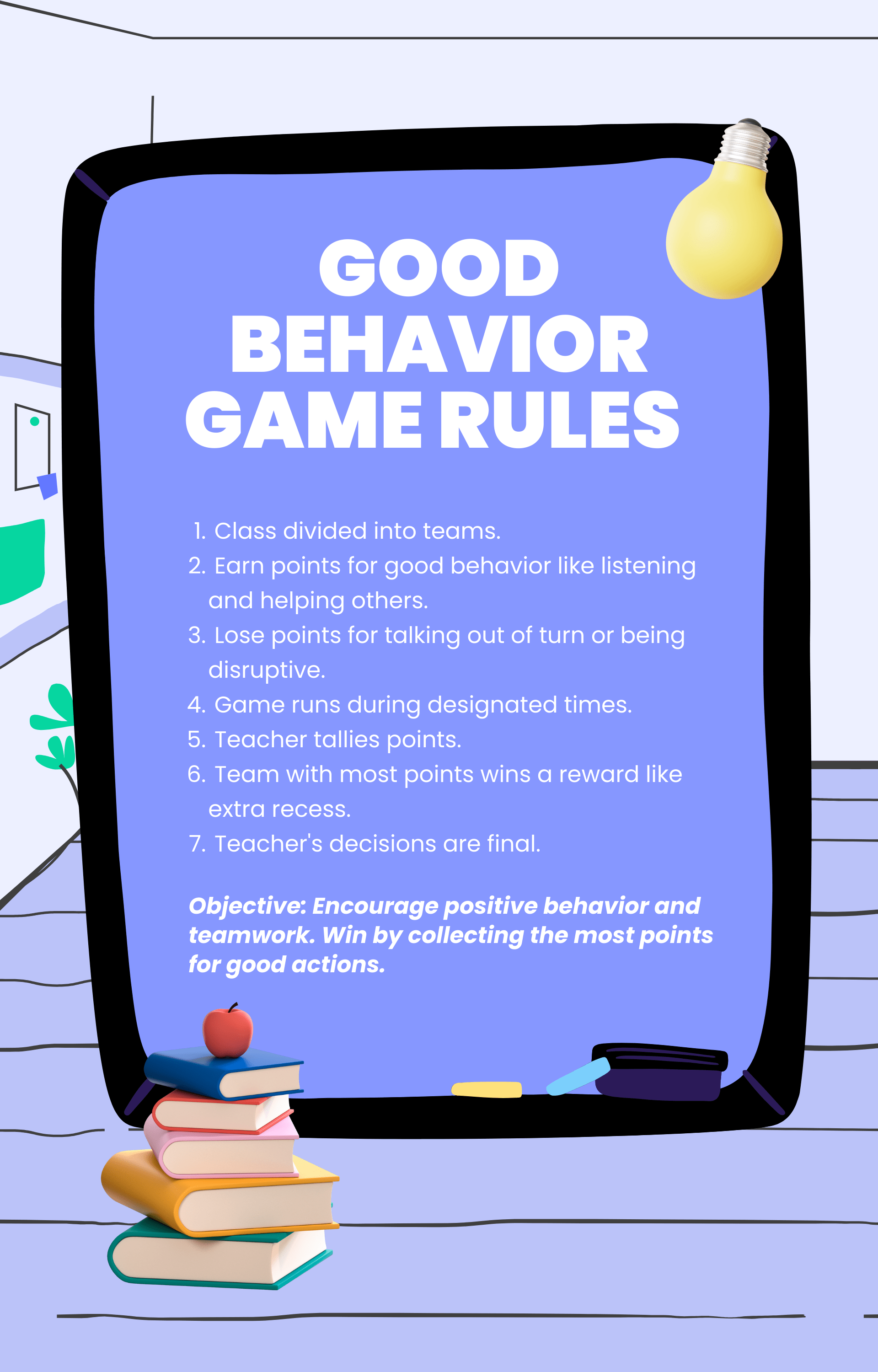
Heard of the Good Behavior Game? It’s an evidence-based approach designed to improve classroom conduct through team-based competitions.
This isn’t just the brainchild of some creative teachers; it’s actually supported by extensive research. According to a study from Johns Hopkins University, classrooms implementing this game showed significant reductions in disruptive behaviors.
- How It Works: Divide the class into teams. Set specific rules for good behavior. Teams earn points for following the rules and lose points for breaking them.
- Why It’s Effective: It encourages collective responsibility and fosters a positive classroom culture.
25. Response to Intervention (RTI)
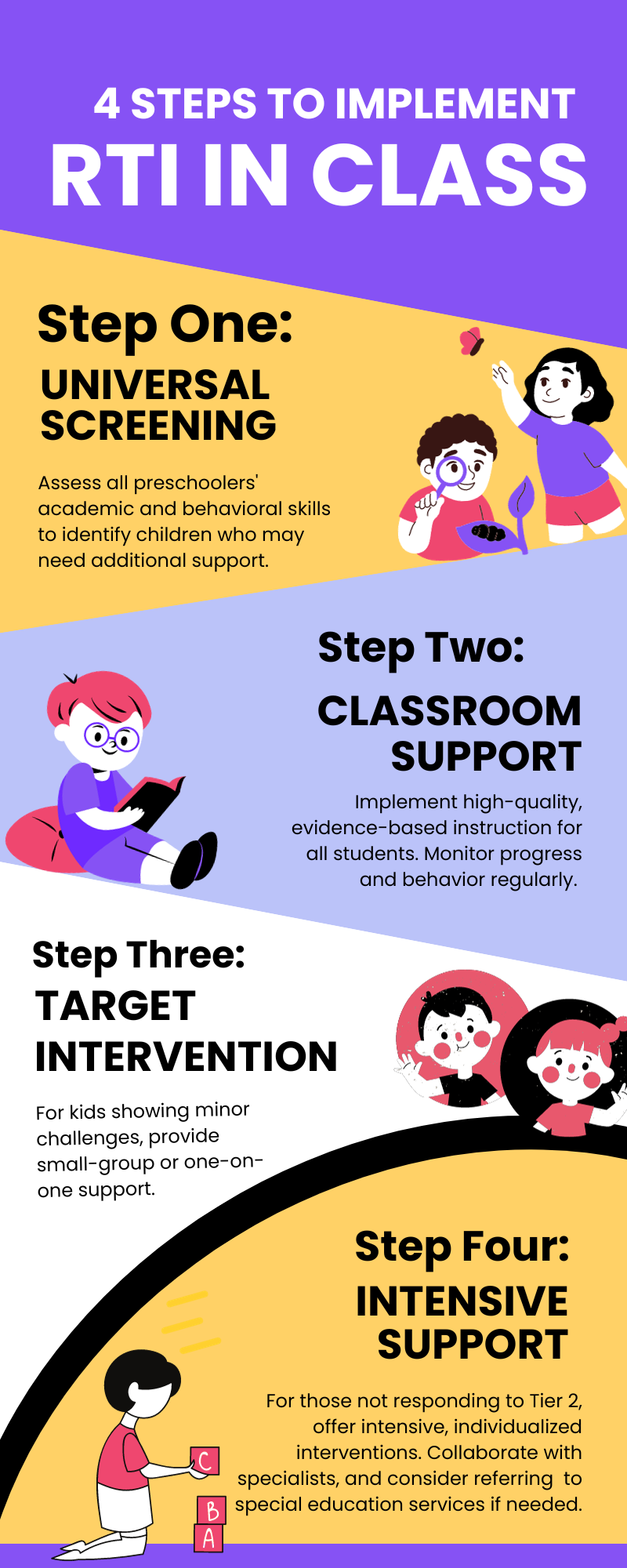
RTI isn’t a new kid on the block; educators have been utilizing this model to adapt to the varying academic and behavioral needs of students. Research suggests it’s remarkably effective in early childhood settings too.
- How It Works: It involves regular assessments and targeted teaching strategies based on individual performance and needs.
- Why It’s Effective: RTI allows teachers to identify struggling students early on and provide focused interventions, thereby improving the overall learning environment.
Grab our helpful RTI Classroom Management plan here.
26. Classroom-wide Function-related Intervention Teams (CW-FIT)
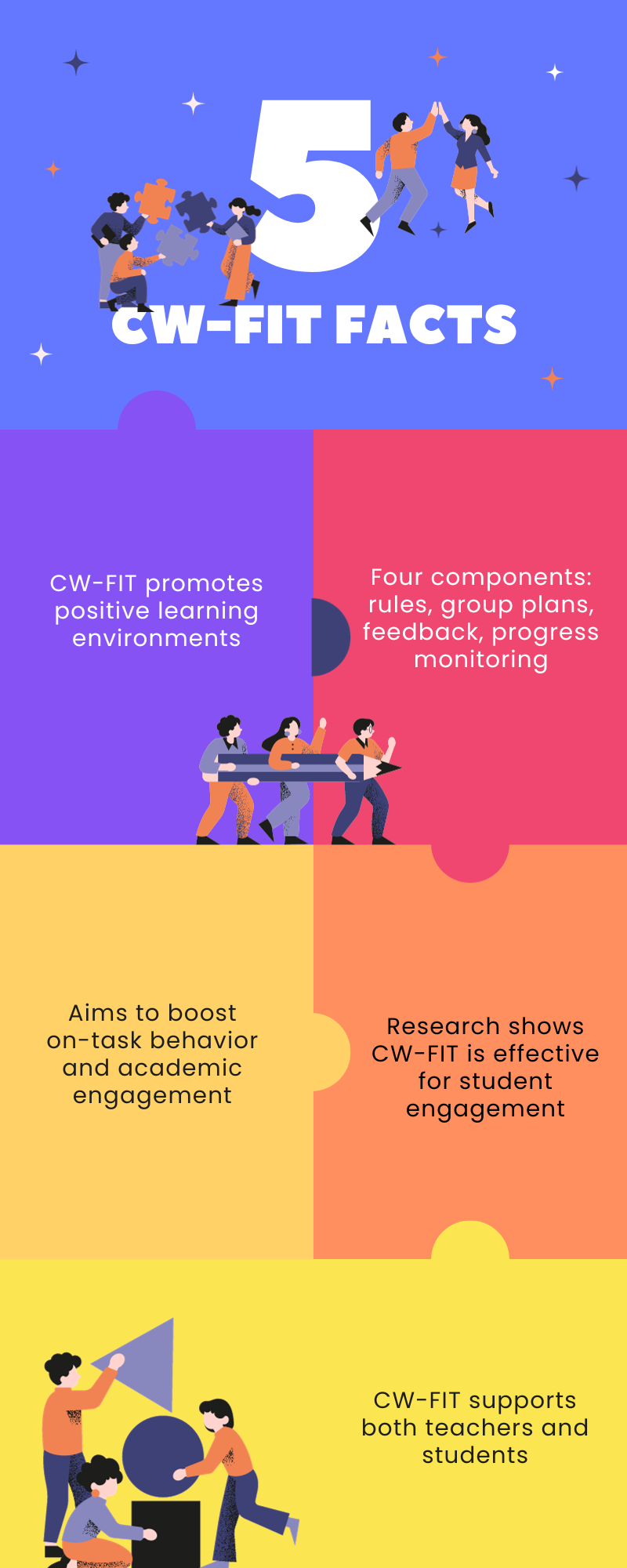
Ever heard of CW-FIT? This clever strategy focuses on specific classroom behaviors and seeks to improve them through direct instruction and social rewards. Studies, such as this one published in the Journal of Positive Behavior Interventions, support its efficacy.
- How It Works: Teachers identify specific behaviors they want to improve and set up a reward system around them.
- Why It’s Effective: It’s a versatile strategy that can be tailored to address various issues, from talking out of turn to difficulty in transitions between activities.
6 Bonus Tips and Ideas for Kindergarten Classroom Management
Your role as a kindergarten teacher is similar to being a conductor in an orchestra—except your musicians are a lively bunch of 5-year-olds.
A comprehensive approach to classroom management can make all the difference. Here, we’ve curated an all-inclusive list of tips and ideas to keep your young learners harmonized and ready to perform.
27. Tech Tools for Classroom Management
In our digital age, even our youngest students can benefit from tech-savvy classroom management strategies for preschool and kindergarten. Apps like ClassDojo, Seesaw, and TeacherKit make your job a tad easier.
- ClassDojo: Enables real-time communication with parents and interactive rewards.
- Seesaw: An interactive learning platform that engages students and involves parents.
- TeacherKit: Helps with administrative tasks like grading and attendance.
- ClassPoint: Offers gamification features that make learning more interactive and fun, in addition to its quiz mode for real-time feedback
These apps not only simplify your life but have been shown to enhance engagement and behavioral outcomes in kids. Harvard’s Education Magazine corroborates the positive impact of tech in early education.
28. Parental Involvement
Let’s face it; you can’t do it alone. Parental involvement is a cornerstone of effective classroom management strategies for kindergarten.
- Newsletters: Keep parents in the loop about what’s happening in the classroom.
- Parent-Teacher Meetings: An excellent avenue for two-way communication.
- Digital Platforms: Use apps to keep an open line of dialogue.
Parents can reinforce classroom behavior strategies at home, which is a win-win for everyone involved.
29. Self-Regulation Activities
Kids aren’t born with self-control. They need to learn it. And guess who’s teaching them? You are!
- Simon Says: It’s more than a game; it’s a lesson in following instructions.
- Deep Breathing: Gets those little minds centered and ready to learn.
- Sensory Jars: A fun, interactive way to calm down and focus.
Self-regulation not only helps the individual but contributes to a more serene classroom environment.
30. Flexible Seating Arrangements
Believe it or not, how you arrange your chairs can affect how your kids behave. It’s a bit like interior design but for preschool classroom management.
- Floor Mats: Encourage active listening.
- Bean Bags: A comfy reading spot can increase focus.
- Group Tables: Encourage teamwork and peer interaction.
A study by the University of Salford found that classroom design could affect academic performance by as much as 25%.
31. Using Music and Songs
Ever noticed how kids are captivated by catchy tunes? Use it to your advantage.
- Transitional Songs: Helps indicate it’s time to move on to the next activity.
- Focus Music: Classical or instrumental music can increase concentration.
Songs like “Clean Up, Clean Up” can make tidying a game rather than a chore.
32. Implementing a Token Economy
Want to keep the positive behaviors rolling in? Try implementing a token economy.
- Tokens for Good Behavior: Physical tokens or digital points can be earned.
- Reward Exchange: Once a certain number is reached, they can be exchanged for a reward.
A review of 22 studies affirmed the positive effects of token economies in educational settings, including kindergartens.
Wrapping Up
Managing a kindergarten classroom doesn’t have to feel like herding cats. With the right blend of tech tools, parental involvement, self-regulation activities, seating arrangements, music, and a token economy, you can create a harmonious learning space that kids and parents will love.
But why stop there? Take your teaching game to the next level with ClassPoint. This interactive teaching tool seamlessly integrates with your PowerPoint presentations, offering live quizzes, polling, and annotations to supercharge your classroom engagement.
Ready to revolutionize your teaching methods? Give ClassPoint a try now, and make every lesson an unforgettable experience. 👇

